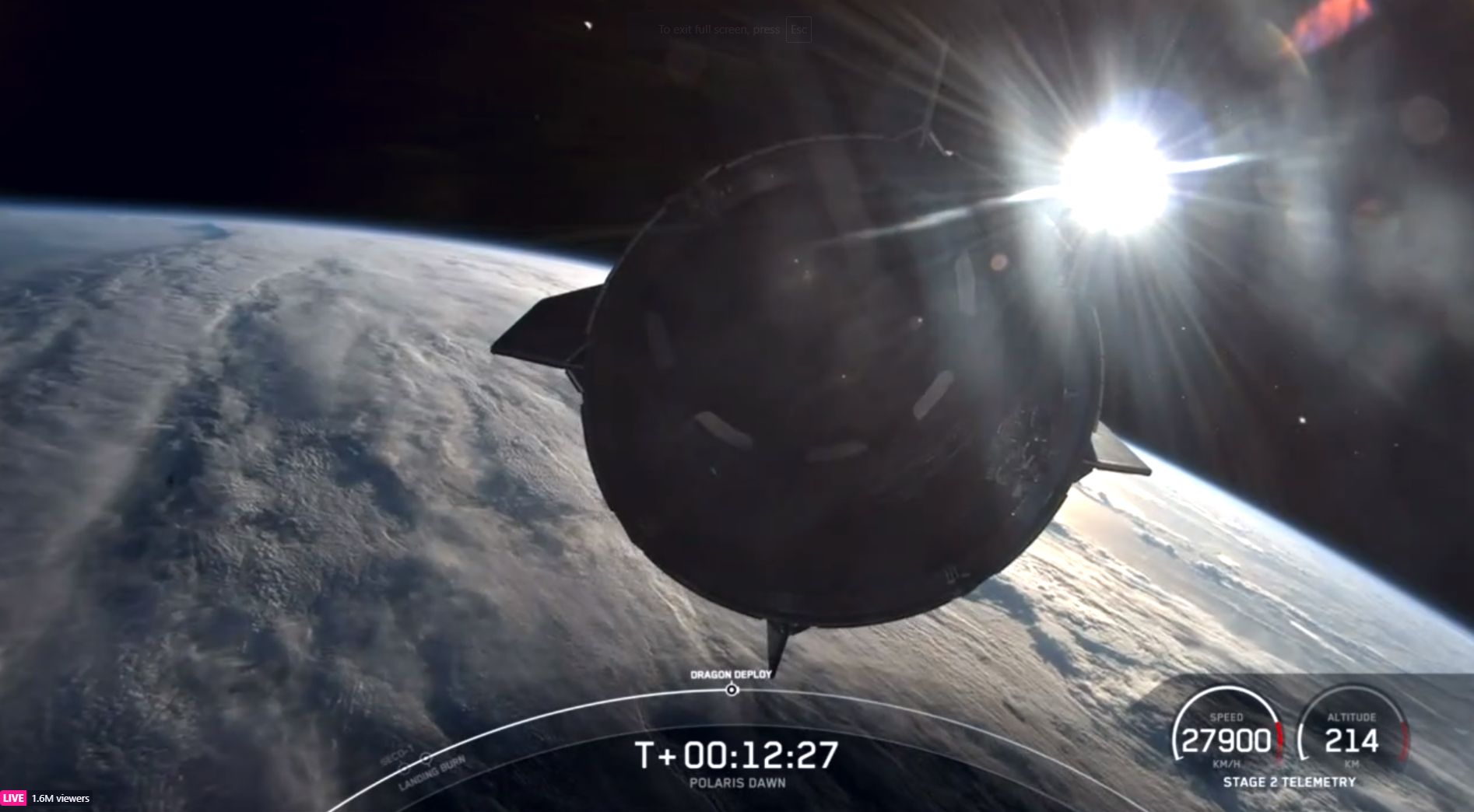

# SpaceX’s Polaris Dawn Mission: Redefining the Frontiers of Private Space Travel
On a serene Tuesday morning, the pre-dawn sky over Florida was brightened by the blazing ascent of a **Falcon 9 rocket**, signaling the start of one of the most ambitious private spaceflights ever attempted. The mission, named **Polaris Dawn**, is headed by billionaire pilot **Jared Isaacman** and seeks to extend the limits of human space exploration, especially in the sector of private space initiatives.

*Crew Dragon spacecraft detaches from the upper stage of a Falcon 9 rocket on Tuesday morning.*
*Credit: SpaceX*
## A Landmark Launch
The Falcon 9 rocket transported four crew members aboard a **Crew Dragon spacecraft** referred to as *Resilience*, which is embarking on its third trip into space. The crew comprises **Jared Isaacman**, **Scott “Kidd” Poteet**, **Anna Menon**, and **Sarah Gillis**. Their mission targets an orbit with an apogee of 1,200 km and a perigee of 190 km, with intentions to elevate the orbit to an apogee of 1,400 km by the end of the first day. This altitude will signify the **greatest distance any individual has ventured from Earth** since the Apollo missions to the Moon more than fifty years ago.
Shortly after liftoff, Isaacman expressed his appreciation to the SpaceX team, stating, *”We wouldn’t be on this journey without all 14,000 of you back at SpaceX.”* The mission exemplifies the expanding capabilities of private spaceflight, enabled by SpaceX’s advanced technology and the commitment of its engineers, flight controllers, and technicians.
## Research Goals and Extravehicular Activities
Among the main objectives of the Polaris Dawn mission is to gather **biological data** to examine the impacts of space radiation at such elevated altitudes. Radiation levels increase dramatically as one ascends beyond Earth’s shielding atmosphere, and the gathered data will be pivotal for future deep-space exploration missions, including those aimed at the Moon and Mars.
Nevertheless, the most awaited segment of the mission is the anticipated **spacewalk**, which will be the **first private spacewalk ever recorded**. The crew will maneuver to a more circular orbit approximately 700 km above Earth’s surface, where Isaacman and Gillis will put on their spacesuits and briefly leave the spacecraft. This historic moment will also serve as a vital test for SpaceX’s latest spacesuit technology.
### SpaceX’s Development of Spacesuits
The spacesuits for the Polaris Dawn mission signify **version 1.0** of a design that may someday be utilized by astronauts exploring the surface of the Moon or Mars. This mission has hastened SpaceX’s schedule for spacesuit advancement, and the insights gained from this spacewalk will shape future designs of the suit. As private space exploration continues to flourish, the demand for dependable, robust spacesuits will increasingly escalate, particularly for missions that involve extravehicular activities (EVAs).
## Starlink Communication Systems and Scientific Experiments
Alongside the spacewalk, the crew will undertake a range of **scientific experiments** throughout their five-day mission. A significant part of these experiments involves evaluating **Starlink-based communications** in space. Starlink, SpaceX’s satellite internet network, has already transformed global communication on Earth, and this mission will investigate its applicability in the cosmos. Effective communication is crucial for future extended missions, especially those moving beyond low Earth orbit.
## Return and Weather Implications
The Polaris Dawn mission is anticipated to last up to five days, after which the crew will return to Earth, landing in the waters surrounding Florida, either in the **Atlantic Ocean** or the **Gulf of Mexico**. However, weather conditions play a vital role in determining the landing timing. The mission’s success is contingent on accurate five-day weather predictions, as the Dragon spacecraft carries a finite supply of food and necessities.
The crew encountered several delays leading up to the launch due to weather factors. Initially set for August 27, the mission was postponed because of a helium leak in the ground systems. After resolving that issue, the team awaited favorable weather for both launch and splashdown. The waters near Florida had been tumultuous for weeks, but conditions finally started to improve, permitting the mission to go ahead.
On Monday, SpaceX meteorologists became more confident about the splashdown conditions for the weekend, and attention turned to the weather at the launch site. Following a short delay due to nearby rain showers, the skies cleared, and at **5:23 am ET**, the Falcon 9 rocket launched, marking SpaceX’s **88th launch of the**